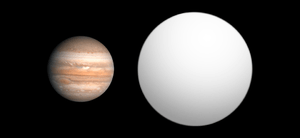OGLE-TR-10b
| Extrasolar planet | List of extrasolar planets | |
|---|---|---|
 | ||
| Parent star | ||
| Star | OGLE-TR-10 | |
| Constellation | Sagittarius | |
| Right ascension | (α) | 17h 51m 28.25s |
| Declination | (δ) | −29° 52′ 34.9″ |
| Distance | ~5000 ly (~1500 pc) | |
| Spectral type | G or K | |
| Orbital elements | ||
| Semimajor axis | (a) | 0.04162 ± 0.00004 AU |
| Orbital period | (P) | 3.10129 ± 0.00001 d |
| Inclination | (i) | 84.5 ± 0.6° |
| Semi-amplitude | (K) | 100 ± 43 m/s |
| Physical characteristics | ||
| Mass | (m) | 0.63 ± 0.14 MJ |
| Radius | (r) | 1.26 ± 0.07 RJ |
| Density | (ρ) | 420 kg m−3 |
| Surface gravity | (g) | 0.94 g |
| Discovery information | ||
| Discovery date | Dec 20, 2002 | |
| Discoverer(s) | Konacki et al. | |
| Discovery method | Transit | |
| Discovery site | Las Campanas Observatory in Chile | |
| Discovery status | Confirmed | |
| Database references | ||
| Extrasolar Planets Encyclopaedia | data | |
| SIMBAD | data | |
| Exoplanet Archive | data | |
| Open Exoplanet Catalogue | data | |
OGLE-TR-10b is an extrasolar planet orbiting the star OGLE-TR-10.
The planet was first detected by the Optical Gravitational Lensing Experiment (OGLE) survey in 2002. The star, OGLE-TR-10, was seen dimming by a tiny amount every 3 days. The transit lightcurve resembles that of HD 209458 b, the first transiting extrasolar planet. However, the mass of the object had to be measured by the radial velocity method, because other objects like red dwarfs and brown dwarfs can mimic the planetary transit. In late 2004 it was confirmed as the 5th planetary discovery by OGLE.[1]
The planet is a typical "hot Jupiter", a planet with a mass half that of Jupiter and orbital distance only 1/24th that of Earth from the Sun. One revolution around the star takes a little over three days to complete. The planet is slightly larger than Jupiter, probably due to the heat from the star.

OGLE-TR-10 was identified as a promising candidate by the OGLE team during their 2001 campaign in three fields towards the Galactic Center.[2] The possible planetary nature of its companion was based on spectroscopic follow-up.[1] A reported a tentative radial velocity semi-amplitude (from Keck-I/HIRES) of 100±43 m/s, and a mass for the putative planet of 0.7 ± 0.3 MJup was confirmed in 2004 with the UVES/FLAMES radial velocities. However, the possibility of a blend could not be ruled out.[3]
A blend scenario as an alternative explanation from an analysis combining all available radial velocity measurements with the OGLE light curve. OGLE-TR-10b has a mass of 0.57 ± 0.12 MJup and a radius of 1.24 ± 0.09 RJup. These parameters bear close resemblance to those of the first known transiting extrasolar planet, HD 209458 b.[4]
Note that the planets with the longer periods in the hot Jupiter class all have small masses (~0.7 MJup), while all the short-period planets (i.e., very hot Jupiters) have masses roughly twice as large. This trend may be related to the survival of planets in proximity to their parent stars.[5]
References
- ↑ 1.0 1.1 Konacki, Maciej et al. (2005). "A Transiting Extrasolar Giant Planet around the Star OGLE-TR-10". The Astrophysical Journal 624 (1): 372–377. arXiv:astro-ph/0412400. Bibcode:2005ApJ...624..372K. doi:10.1086/429127.
- ↑ Udalski, A. et al. (2002). "The Optical Gravitational Lensing Experiment. Search for Planetary and Low-Luminosity Object Transits in the Galactic Disk. Results of 2001 Campaign". Acta Astronomica 52 (1): 1–37. arXiv:astro-ph/0202320. Bibcode:2002AcA....52....1U.
- ↑ Bouchy, F. et al. (2005). "Doppler follow-up of OGLE transiting companions in the Galactic bulge". Astronomy and Astrophysics 431 (3): 1105–1121. arXiv:astro-ph/0410346. Bibcode:2005A&A...431.1105B. doi:10.1051/0004-6361:20041723.
- ↑ Pont, F. et al. (2007). "The "666" collaboration on OGLE transits I. Accurate radius of the planets OGLE-TR-10b and OGLE-TR-56b with VLT deconvolution photometry". Astronomy and Astrophysics 465 (3): 1069–1074. arXiv:astro-ph/0610827. Bibcode:2007A&A...465.1069P. doi:10.1051/0004-6361:20066645.
- ↑ Mazeh, Tsevi et al. (2005). "An intriguing correlation between the masses and periods of the transiting planets". Monthly Notices of the Royal Astronomical Society 356 (3): 955–957. arXiv:astro-ph/0411701. Bibcode:2005MNRAS.356..955M. doi:10.1111/j.1365-2966.2004.08511.x.
External links
![]() Media related to OGLE-TR-10b at Wikimedia Commons
Media related to OGLE-TR-10b at Wikimedia Commons